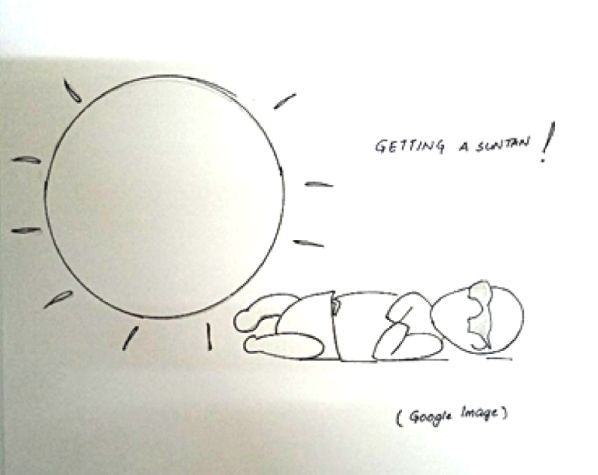Tracking your Health
Miss Eloni
Post Basic Dip in Neonatal Nursing, Neonatal ICU in-Charge, CIHSR
Jaundice is a yellow discoloration of the skin and the white part (the sclera) of the eyes. It results from having too much of a substance called bilirubin in the blood. Bilirubin is formed when the body breaks down old red blood cells. The liver usually processes and removes the bilirubin from the blood. Jaundice in newborn babies usually occurs because of a normal increase in red blood cell breakdown and their liver is not mature enough to remove bilirubin from the blood. It may also be caused by a number of other medical conditions.
Types of Neonatal Jaundice
1. Physiological Jaundice:
Physiologic jaundice is the most common form of newborn jaundice. It appears after 24 hours of life. i.e. 2-3 days after birth. The baby's liver plays the most important part in bilirubin breakdown. The type of bilirubin that causes the yellow discoloration of jaundice is called unconjugated or indirect bilirubin. This form of bilirubin is not easily removed from the baby's body. The baby's liver changes this unconjugated bilirubin into conjugated or direct bilirubin, which is easier to excrete. The liver of a newborn baby is immature, so the job of conjugating and removing bilirubin is not done completely well. This causes an elevation of bilirubin, which gets circulated in the body, and gets deposited on skin, nails and eyes, causing the yellow discoloration. As the breakdown of red blood cells slows down, and the baby's liver matures, the jaundice rapidly disappears. When jaundice is due to these factors alone, it is termed physiologic jaundice.
2. Pathological Jaundice:
Pathological jaundice appears within 24 hours of life. It can be seen in cases where baby’s blood group is different from that of mother. The mother's body will produce antibodies that attack the baby's blood cells. This causes a breakdown of the red blood cells and thus an increased release of bilirubin from the red cells. Sometimes jaundice may appear after 24 hours, but the level of jaundice will be very high, which can cause potential harm to the developing brain and hearing. This is also pathological jaundice. Some disease conditions like umbilical sepsis, congenital obstruction by absence or stricture of common bile duct, viral hepatitis, toxoplasmosis, intracranial hemorrhage, cephalohematoma, defective conjugation of bilirubin, etc. can cause Pathological Jaundice.
Newborn Jaundice Symptoms
As the baby’s bilirubin level rises, jaundice spreads from the face downwards, to involve the arms, trunk, and finally the legs. If the bilirubin levels are very high, baby will appear jaundiced below the knees and over the palms of his or her hands. Jaundice can be hard to see especially in babies with dark skin. One easy way to check for jaundice is to press a finger against the baby's skin, nose or forehead for 2-3 seconds and release it. Normal skin will turn white when you do this, but jaundiced skin will stay yellow.
Older children and adults will appear jaundiced when the amount of bilirubin in their blood is above 2 milligrams per deciliter (mg/dl). Newborn babies will begin to appear jaundiced when they have more than 5 mg/dl of bilirubin in their blood. It is important to recognize and treat jaundice because high levels of bilirubin can cause permanent damage to a baby's brain. This brain damage is called kernicterus.
When to seek Medical Care?
1. If the baby has jaundice during the first 24 hours of life(Pathological)
2. If the jaundice is spreading or getting darker or more intense
3. If the baby has a fever over 1000F/ 37.80C
4. If the baby starts to look or act sick
5. If the baby is not feeding well
6. If the baby is sleepier than usual
7. If the baby is having breathing difficulty or begins to turn blue
Treatment:
Phototherapy is often used to treat neonatal jaundice. It is non-invasive, inexpensive and easy method. The baby is kept on a warmer under special lights. These light waves are able to penetrate a baby’s skin and convert the bilirubin into water soluble non-toxic form which is easily excreted from the bile, stool and urine. Phototherapy can be given continuously or intermittently using fluorescence or halogen light. The wavelength of the light should be in the range of 420 to 600 nm for maximum effect. Exposing to sunlight does not cure jaundice because the available light does not fall in this range.

Exposing to sunlight does not cure jaundice!
The baby is placed naked under the light source at a distance of about 45 cm. It can be reduced to 15 to 20 cm for intensive phototherapy. The eyes are covered to prevent retinal damage and a diaper be kept on to cover the genitals especially in male baby to prevent gonadal damage. More frequent breastfeeding is advised because frequent feed can flush the bilirubin through urine and stool. Extra fluid to be provided by IV infusion or nasogastric tube feeding to prevent dehydration.
Jaundice usually settles on its own but rarely, if it persists beyond 14th day, it is known as breastmilk jaundice which is treated by replacing breast milk with formula feed for 48 hours. Once the jaundice settles, can restart with breastfeeding.
Myths and facts:
1. Neonatal jaundice is due to wrong eating habits of the mother
Neonatal jaundice is caused by breakdown of red blood cells which leads to the production of bilirubin. Bilirubin deposition on the skin, eyes and mouth will cause it to have a yellow tinge. Up to 60% of newborns have jaundice and most of the time, it is due to the liver being too immature to handle the high levels of bilirubin. There is no known foods or drinks that will cause or worsen jaundice in babies.

I’m so hungry because my mother is on food restriction for my jaundice, and not having enough milk!
2. Baby can suffer from jaundice later if he/she had it as a newborn
Most neonatal jaundice cases are physiological and only happen during the first few days of life. Jaundice that manifests later in life has no link to neonatal jaundice.
3. Neonatal jaundice can be treated by exposing the baby to sunlight
It is not a safe way of treating jaundice when the bilirubin is high. This is not recommended as baby can become dehydrated which, in turn, worsen the jaundice. Direct sunlight and UV rays can cause painful sunburn to the thin newborn skin.Phototherapy is a better way to treat neonatal jaundice where the baby is kept under special lights.
4. Baby with jaundice will die if Intravenous fluids are given
Extra fluids are needed to prevent dehydration especially when baby is on phototherapy.
Adequate fluids in the body will help to flush the unwanted bilirubin through urine and stool.

My mother breast fed me frequently and got rid of my jaundice!





